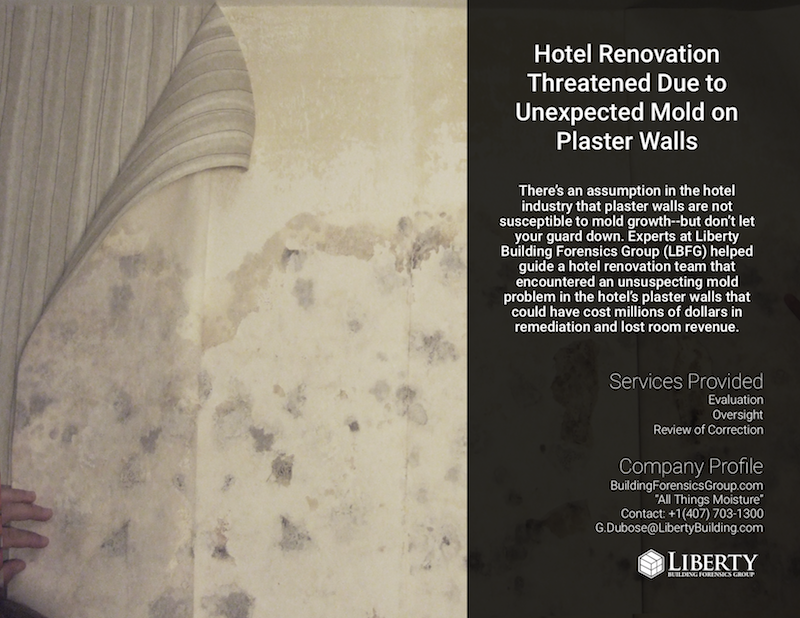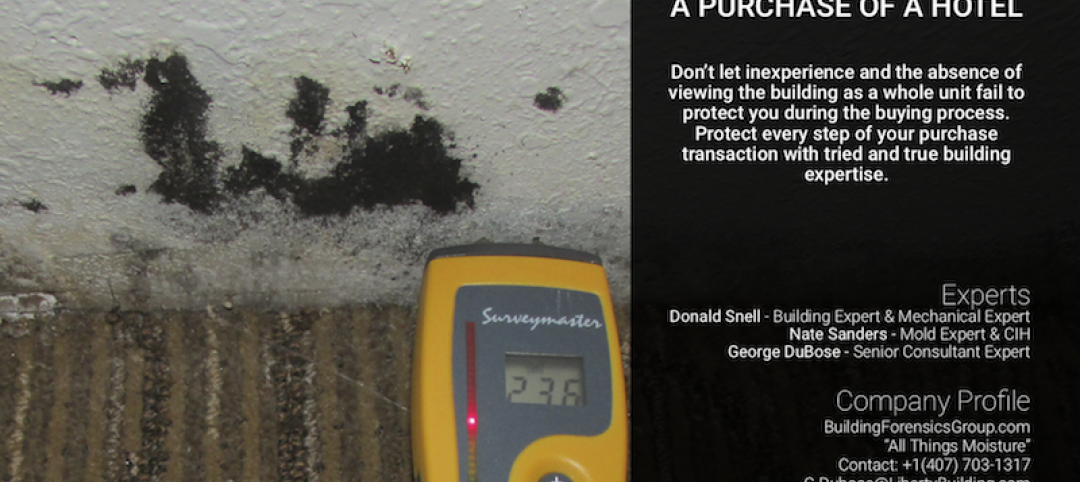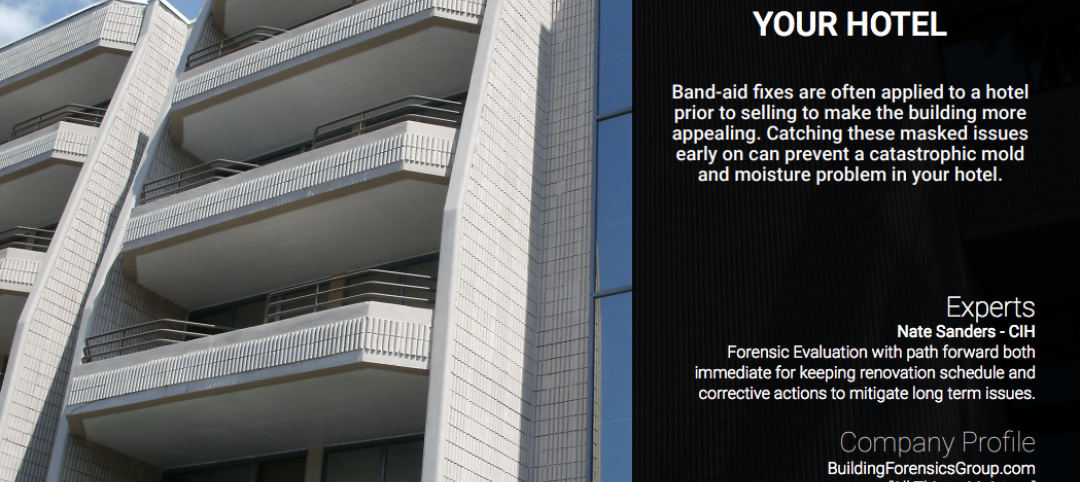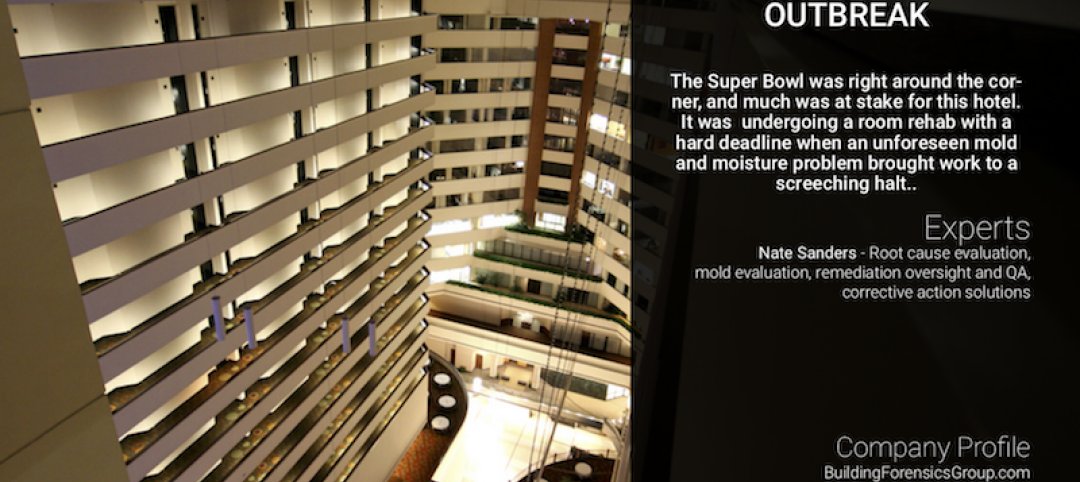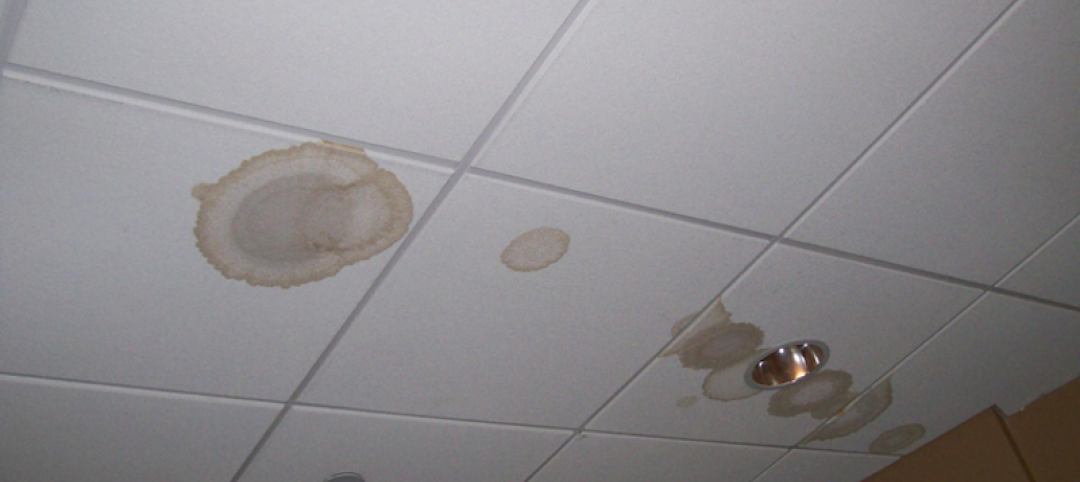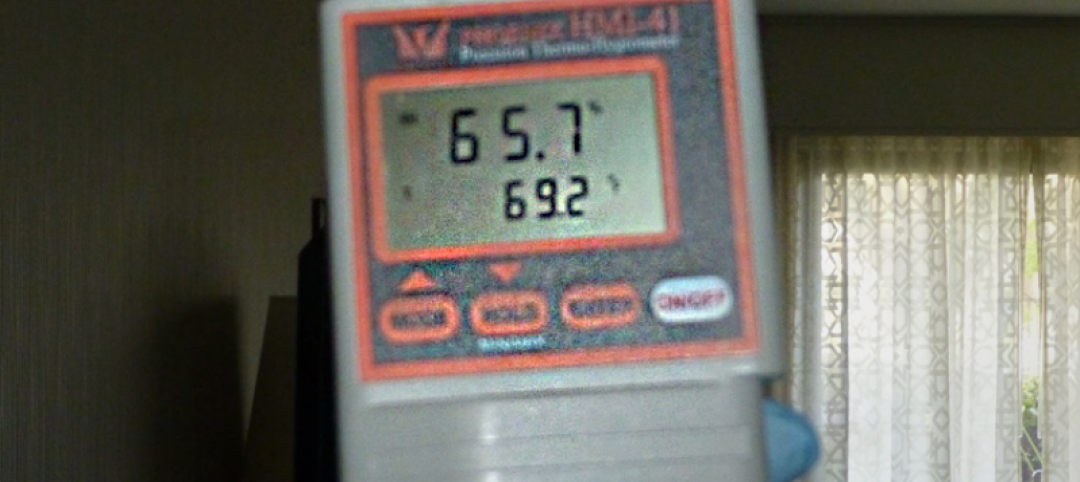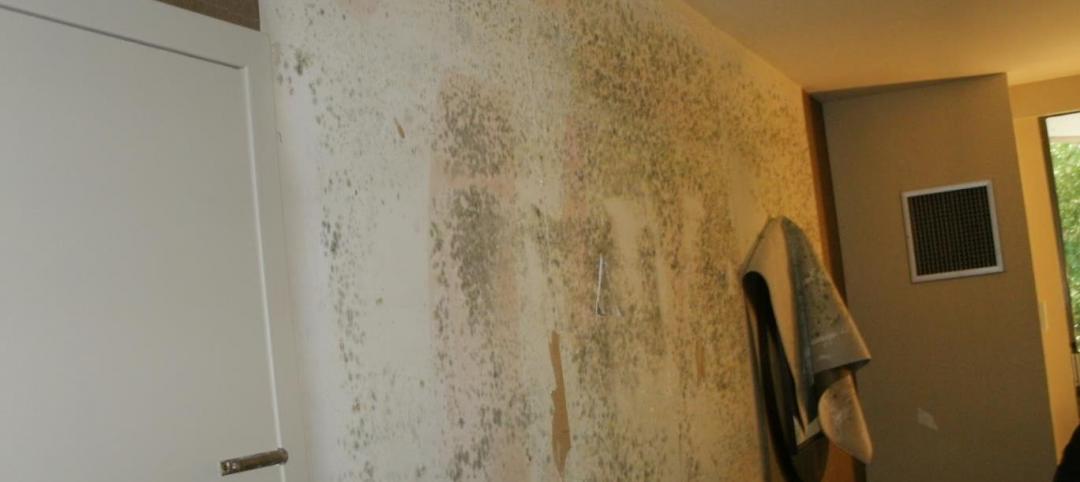There’s an assumption in the hotel industry that plaster walls are not susceptible to mold growth--but don’t let your guard down. Experts at Liberty Building Forensics Group (LBFG) helped guide a hotel renovation team that encountered an unsuspecting mold problem in the hotel’s plaster walls that could have cost millions of dollars in remediation and lost room revenue.
Mold growth is not seen as frequently on plaster walls as it is on gypsum wallboard, primarily because there are no nutrients to support mold growth (except for any dirt or dust that might be on the plaster). As a result, any mold growth on plaster walls is often not very visible or extensive, so most hotel owners and operators in this situation feel relatively safe from mold problems. It is important to realize, however, that what unexpectedly happened to this high-end hotel with plaster walls in the heart of Washington, D.C. could happen to anyone.
Case Summary
Hotel management was attempting to fast-track a renovation project because of a high demand for room nights in this particular location of Washington, D.C. Part of the renovation process involved removing all the old vinyl wall covering on the corridor walls and in the rooms themselves, then patching and repairing the underlying plaster with skim coats, allowing that to dry before installing the new vinyl wall covering.
Much to the dismay of everyone involved, mold was found growing behind the new vinyl wall covering while renovations were still ongoing. The mold was found growing primarily on the adhesive (which served as a nutrient), as well as on any dirt and dust that might have been on the plastered surface. This mold growth caused a discoloration of the vinyl wall covering, with pink stains appearing on both the room and corridor sides of the vinyl. The discoloration was noticeable to the hotel staff and would have been noticeable to guests as well, thus bringing this fast-track renovation to a halt.
This delay not only increased renovation costs due to unplanned remediation, but also extended room outages for the newly-renovated rooms. A delay like this can be quite detrimental to a hotel and can potentially even close its doors. When preparing for a room rehab at an existing hotel, hotel decision-makers spend a tremendous amount of time planning the outage windows--not only by floors or blocks of rooms, but also in terms of the overall outage numbers possible in order to keep the hotel operational and not disruptive to other guests. Some hiccups are expected while the first or second floors are being renovated because it can take some time to get the kinks worked out, but usually nothing too serious is encountered. In the case of this high-end hotel, however, our client was suddenly facing the risk of not being able to get entire floors back into operation within a reasonable timeframe.
Room outage costs can quickly escalate into significant numbers during hotel room rehabs. In this particular situation, some room outage timeframes were now being extended by 50%. Going from a four-week floor outage to a six-week floor outage would increase lost revenue drastically. Each unoccupied floor cost $300,000 to $400,000 a week in lost revenue due to room outages. Extending that loss over the 15 to 20 floors that made up this hotel would easily lead to seven-figures. The owner, project manager, contractor, and designers were desperately trying to determine how to safely move forward while still completing the room rehab. Little progress was made until LBFG arrived and helped guide the team back to a successful rehab.
CHALLENGE
Unfortunately, all of the new vinyl wall covering had to be pulled down in order to search for the source of the mold problem and remediate it. Since the hotel was on a fast-track renovation time frame, this additional effort was causing significant delays, thus increasing unexpected costs and decreasing the room revenue stream. LBFG discovered that the construction team had overlooked-the drying potential of the walls. Although plaster walls are pervious to moisture, they are unable to support an abundant amount of moisture, such as what was contained in the skim coating.

Even though the skim coating had appeared to be dry both to the touch and during a visual inspection, a significant amount of moisture had been buried into the core of the skim coat. This moisture had become trapped by the vinyl going up too quickly. Adding to the problem was the fact that ceramic tile was on the other side of the wall in many locations (as bathrooms are typically common to corridor walls) and was acting as a vapor retarder. So the moisture was trapped between two impervious wall surfaces: vinyl covering on the corridor side and ceramic tile on the room side. (A similar mold problem was discovered on interior demising walls that had vinyl on both sides, again trapping in the moisture.)
SOLUTION
LBFG was called in to provide a rapid response by assessing the mold problem that presented soon after the new wall finish was installed in the corridors. The hotel was facing the huge risk of a derailed flow of production because the mold growth was preventing them from moving forward. LBFG experts J. David Odom and Richard Scott made a slight adjustment to a minor aspect of the room rehab, elongating one task duration while supplementing it with enhanced drying capabilities, thus allowing the project to continue.
Their solution was to slow down the pace of the work enough to allow sufficient time for the skim coat to dry. Drying equipment was also strategically installed to reduce the humidity in the hotel. This renovation was taking place during the winter which allowed a smaller moisture load from outdoors so the mechanical systems were turned off, but the humid conditions existed within the hotel due to the moisture being added by the skim coat.
LBFG also performed more complete checks on the drying potential of the skim coat material, including assessing walls where existing materials such as ceramic tile had previously impeded the drying process and taking extra precautions in those areas to be sure the skim coating was thoroughly dry before starting to apply the vinyl wall covering.
RESULT
The solution was simple yet effective, allowing the room rehab to keep moving forward at a rate that satisfied the client but also ensured the reduced risk of another mold problem. By using proper diagnostics and installing strategically located drying equipment, LBFG was able to ensure that the skim coats dried more quickly than usual, allowing new vinyl wall covering to be installed on an expedited schedule. This propelled the entire project ahead, satisfying the client’s expectations to get room revenues running as quickly as possible.
Liberty Building Forensics Group is committed to SOLVE. FIX. PREVENT. RECOVER the world’s most complex building mold and moisture failures. Our firm has project experience in the U.S., Canada, Mexico, the Caribbean, Central America, the Middle East, Southeast Asia, and Europe. Contact us at g.dubose@libertybuilding.com or by phone at 407/467-5518 or visit us at http://www.buildingforensicsgroup.com/.
More from Author
Richard Scott-AIA, NCARB, LEED AP of Liberty Building Forensics Group | Mar 1, 2019
How to protect yourself from hidden mold problems during a purchase of a hotel
Don’t let inexperience and the absence of viewing the building as a whole unit fail to protect you during the buying process. Protect every step of your purchase transaction with tried and true building expertise.
Richard Scott-AIA, NCARB, LEED AP of Liberty Building Forensics Group | Feb 7, 2019
Don't let a simple band-aid fix cause a mold problem in your hotel
Band-aid fixes are often applied to a hotel prior to selling to make the building more appealing. Catching these masked issues early on can prevent a catastrophic mold and moisture problem in your hotel.
Richard Scott-AIA, NCARB, LEED AP of Liberty Building Forensics Group | Jan 28, 2019
Hotel renovation for the Super Bowl halted due to mold outbreak
The Super Bowl was right around the corner, and much was at stake for this hotel. It was undergoing a room rehab with a hard deadline when an unforeseen mold and moisture problem brought work to a screeching halt.
Richard Scott-AIA, NCARB, LEED AP of Liberty Building Forensics Group | Jan 14, 2019
Air barriers: Expectations vs. reality
When new building code requirements require high performance and innovation incentives, such as those found in green building rating systems, significant confusion and some building failure will ensue.
Richard Scott-AIA, NCARB, LEED AP of Liberty Building Forensics Group | Nov 20, 2018
Monitor these 9 vital signs to avoid widespread mold & moisture problems in your building
Many building owners and operators rely solely on a property condition assessment (PCA) to determine if they have a problem.
Richard Scott-AIA, NCARB, LEED AP of Liberty Building Forensics Group | Jul 13, 2018
Hotel renovation: More than just minding the dust
Do you know the vital signs for avoiding moisture & mold problems? Will your brand standards cause you headaches? How will you recover costs if you do get into trouble?

